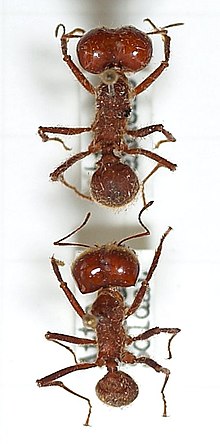Atta sexdens
| Atta sexdens | |
|---|---|
 |
|
| A. sexdens soldier caste workers | |
| Scientific classification | |
| Kingdom: | Animalia |
| Phylum: | Arthropoda |
| Class: | Insecta |
| Order: | Hymenoptera |
| Family: | Formicidae |
| Subfamily: | Myrmicinae |
| Genus: | Atta |
| Species: | A. sexdens |
| Binomial name | |
|
Atta sexdens (Linnaeus, 1758) |
|
Atta sexdens is a species of leafcutter ant belonging to the tribe Attini, native to the New World, from the southern United States (Texas) to northern Argentina. They are absent from Chile. They cut leaves to provide a substrate for the fungus farms which are their principal source of food. Their societies are among the most complex found in social insects. A. sexdens is an ecologically important species, but also an agricultural pest. Other Atta species, such as Atta texana, Atta cephalotes and others, have similar behavior and ecology.
A. sexdens colonies are primarily subterranean with a mound of excavated material on the surface. The diameter of the colony may reach 10 m with a depth of 6 m. The colonies contain up to 2000 chambers with a combined volume of more than 20 m3. The two basic types of chambers are fungus farms and waste chambers. The farms contain the fungal culture which sustains the colony and hosts larvae and pupae. The waste chambers are located at the rim of the colony and are significantly larger. They are used to dispose used fungal culture and dead ants. A mature colony contains 5–8 million workers. The colony often forms the centerpiece of a large jungle clearing. At the top of the mound are structures resembling sand castles surrounding hundreds of openings to the colony. Positioning the openings on top of these structures minimises the amount of rainwater flowing into the colony. The openings also have an important role in air conditioning. As the ant activity and fungal metabolism heat up the colony, hot air rises through the central passageways. Simultaneously, fresh air is drawn in from the openings at the rim of the colony.
A. sexdens follows the basic body plan of ants fairly closely. They have sharp spikes or hooks rising from their heads and midsections to deter predators. Another distinguishing feature is a relatively large, two-lobed head. Its purpose is to accommodate the large muscles moving the well-developed mandibles.
...
Wikipedia
